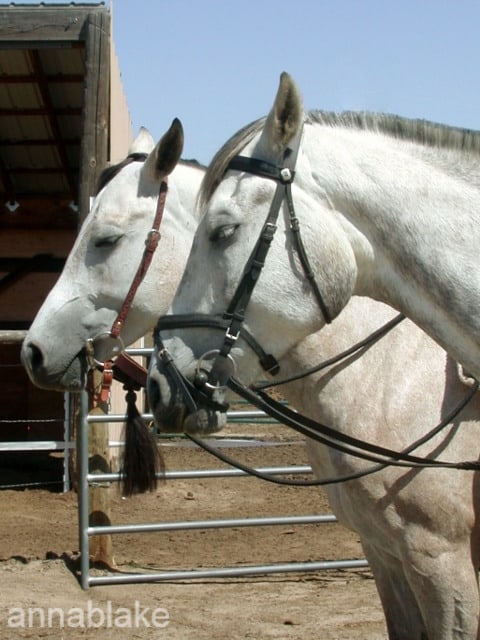 The first thing she said in her lesson was that this horse had sent her to the emergency room more often than she could count.
The first thing she said in her lesson was that this horse had sent her to the emergency room more often than she could count.
(I don’t mean to sound self-serving, but really, you just now got around to talking with a trainer? If you’re getting hurt, get some help! This is how riders become frightened and horses end up in rescue, when a little coaching from the ground could resolve the problem.)
He bolted with her all the time, she said. He was a lovely, dark gelding with some draft in him; quiet, smart, and big. He looked like an equine Labrador Retriever. That soon changed.
She walked away from the mounting block with short reins and tight elbows. Mutual pulling started just a stride at a time, she closed her hands and he felt the restriction. She shortened her reins and he answered with more resistance. He tensed his pol and set his jaw, the tug of war was on. She held fast, he couldn’t breathe so he tried to push his nose out. She got visibly nervous and shortened her reins some more. The miscommunication was easy to see, and he was thinking about panicking, claustrophobic about his bit. Was she inadvertently cuing him to bolt?
I asked her to lengthen her reins and she shot me a look of utter disbelief. It was a tug of war she meant to win. So I negotiated, could she slack just her inside rein, just a few strides. She dubiously gave him a fraction of an inch, and the horse gave a small blow, grateful for any relief. It was a start.
“Every aid can achieve the exact opposite of its intended effect through exaggeration and poor timing. The continual rein aid lets the horse get stuck and resistant.” Gustav von Dreyhausen.
A rein aid is only an aid if it helps. They started out fine, and the resistance grew on both sides one step at a time. Think about it: A massive neck on a big horse vs. tiny bird arms on the human. She is never going to out-pull him and the less oxygen that got to his brain, the harder it was for him to relax. He wasn’t trying to bolt, he just needed to breathe. We are always training either resistance or release, your choice.
Maybe you are a western rider and think this doesn’t apply. Maybe you ride on a long rein all the time and then when you need to help your horse, you jerk the slack out of the rein to direct him. He goes from no contact to a full assault in one stride. Is this any less painful for a horse?
Commonly at this point, we change to a more severe bit to control him better. It’s like escalating a war, instead of trying peace talks. When a horse resists the bit, honestly evaluate your contact. His vulnerable jaw is in your hands, and the question is more about mutual trust than control.
The secret of riding on contact is to move forward, and then release more rein than you take up, follow with your hands. Good contact should feel like a long rein to the horse, more supportive than restrictive. If you lose forward when you pick up contact, your hands are too restrictive. It’s like driving with the parking brake on and the fundamental rule applies: Ride back to front, forward!
And now is when I remind you that we don’t ride with our hands, we use our bodies. Pulling on reins is natural to us humans. We are hand fixated. We use our hands to do everything, including thinking! They express our over-controlling natures. Instead, ride with your seat and legs.
If you think you don’t overuse your reins, here’s a test. Get a balance rein. You can buy them online, or just use an old rein or piece of rope. Put it around your horse’s neck and start riding, using it instead of your reins. It’s a sure fire way to find rate your rein dependency. (Hint: Turn from the waist.)
Have you gotten complacent about bits? Bits are metal on bone. No kidding, no padding, just metal on bone, with your hand on the reins. A bit with shanks is worse. If your horse resists his bit, maybe it is time for you to improve your sensitivity and pass it on. This isn’t a dictatorship, you know.
“It is a mistake to keep the horse on the bit for too long. He must be relaxed at the walk on the long rein regularly and afterwards he must be carefully put back together again.” Nuno Oliveira.
Maybe it’s humans who have gotten hard in the mouth about bits.
Anna Blake, Infinity Farm.
You need to be a member of Barnmice Equestrian Social Community to add comments!
Join Barnmice Equestrian Social Community